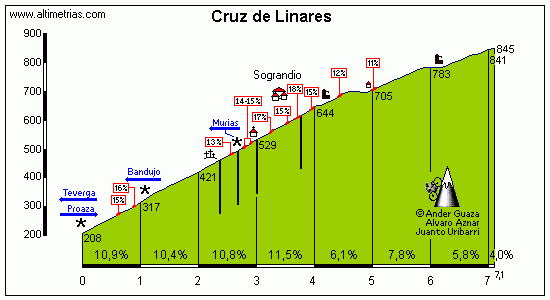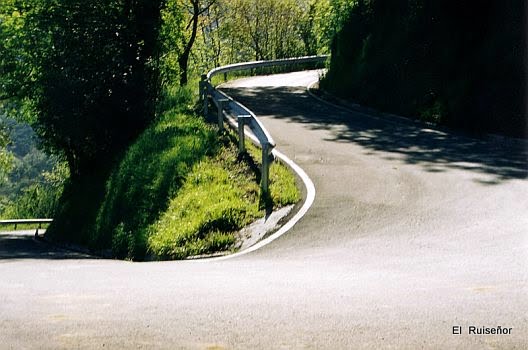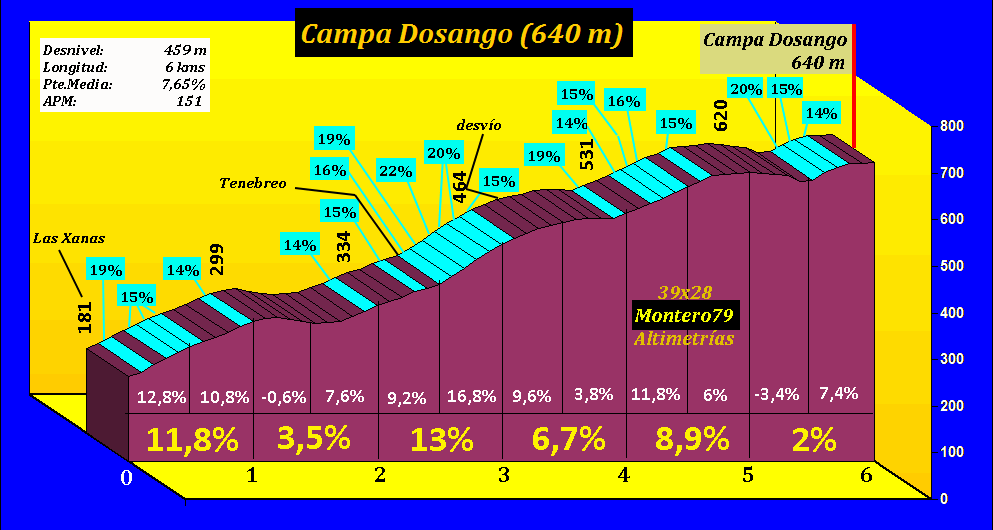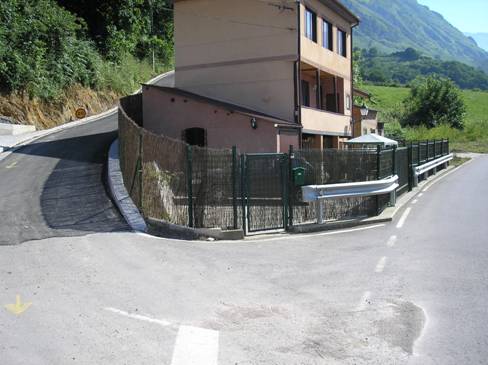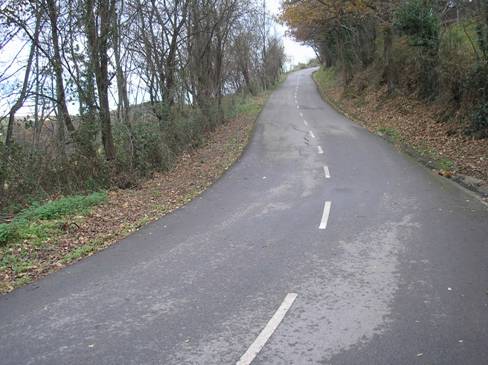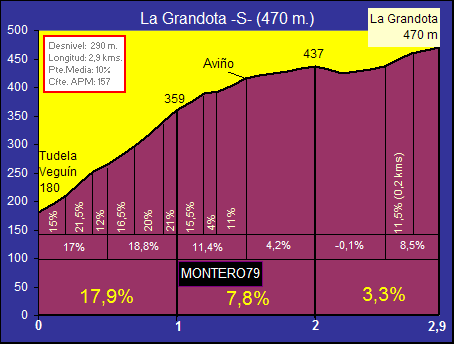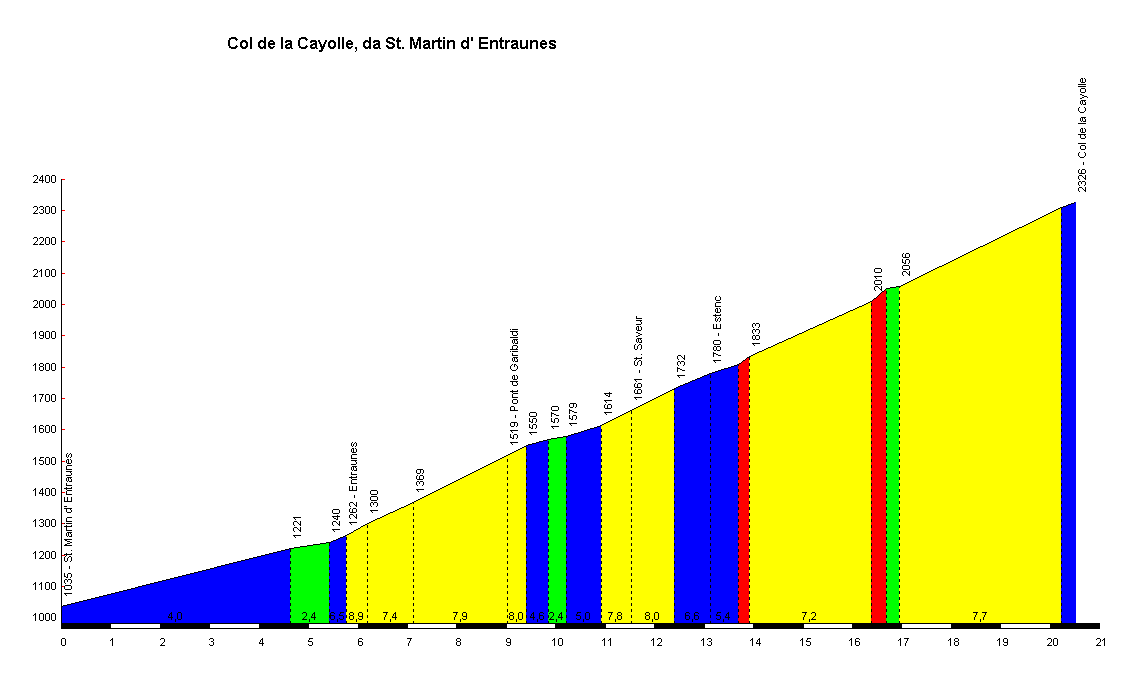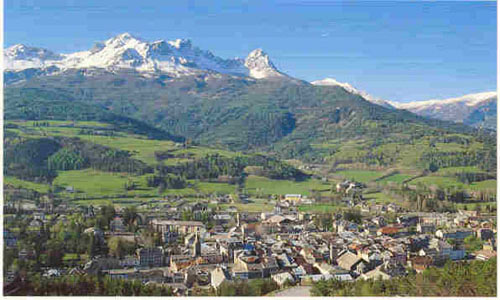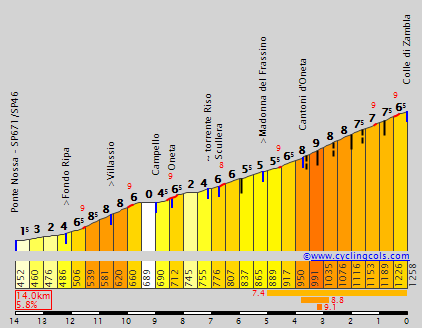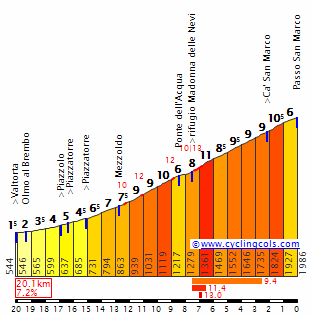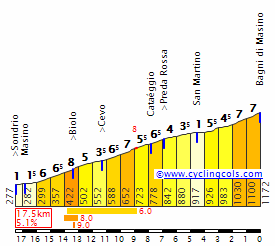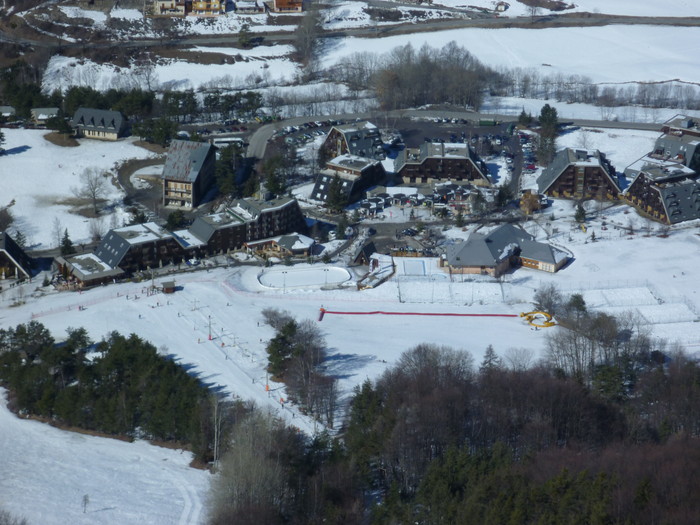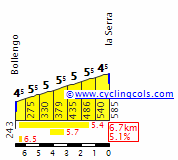Fear not, however, that I am going soft. It's time for the 2nd leg of my "cat.2 and 3 monster stage" trilogy that serves as a centrepiece to this race. Pamplona-Bilbao was the first leg of it, and this is the second. The third comes later, obviously.
Stage 14: León - Oviedo, 185km
GPM:
Alto de La Cobertoria (cat.1) 9,9km @ 8,8%
Cruz de Linares (cat.1) 7,1km @ 9,0%
Alto del Campo Dosango (cat.2) 6,0km @ 7,7%
Alto de La Collá (cat.3) 2,1km @ 11,9%
Alto de Picullanza (cat.3) 2,5km @ 8,7%
Alto de La Grandota (cat.2) 2,9km @ 10,1%
So, does the format of this stage look familiar? It is basically an amped up version of the Bilbao stage, starting on the plateau, descending into the mountainous province, opening with a tough and iconic climb with its steepest gradients in the middle, then leading into a sequence of small but brutal ascents late on before finishing in a major urban centre for the region. But here, the characteristics of the climbs are slightly different. As a piece of course design I prefer the Basque stage, but that's mainly because a) I'm a huge mark for the Basque Country and am more familiar with the variety of climbs on offer there, and b) the closeness of the short climbs near the end allows a really brutal chain of climbs. Here, the climbs are slightly longer on average, but that does mean that they are more spread out. Also, the stage is over 20km shorter. However, with a relatively well-rested péloton after the expected stage for the break in Cantabria and yesterday's sprint, they should be ready to make this one chaos as the penultimate weekend begins.
The first part of the stage, of course, is utterly flat; the plateau in León is higher, so the mountains it descends into are bigger too. However, easing the riders into the stage does mean that we may be left with a comparatively unusual breakaway for such a stage, however I would expect GPM contenders to want to be in this move given the chances of getting to at least the first two cat.2 climbs before the bunch gets serious about the catch - though I expect a hellacious pace from the leaders' teams from Pola de Lena onwards. The first really noteworthy spot we pass is the Puerto de Pajares, an iconic and historic climb in the Vuelta, most recently legendary for the
incredible 2005 stage where Liberty Seguros did a complete number on Menchov's depleted Rabobank team, Roberto Heras tried to kill himself on the La Colladiella descent in order to win the Vuelta, and then his domestiques all waited by the roadside for him to ride over to them to tow him up the historic summit.
Because we're starting on the plateau, there's no real climb as such, then the riders descend this long and wide climb which starts tricky then eases off, but as it's so wide open it's not particularly dangerous, certainly not compared to Ventana or Somiedo, both of which the Vuelta has climbed from the easy side then descended the steep side to set up an Asturian stage in the recent past. Anyway, this descent takes us to the town of Pola de Lena, a beautiful and almost perfectly-located town in northern central Asturias.

Pola de Lena is to the Vuelta what Cortina d'Ampezzo is to the Giro, or at least in an ideal world it is. It sits at the basis of the Alto de La Cobertoria, one of Spain's iconic climbs, and also at the base of the short and steep Alto del Cordal, used regularly as Angliru's lead-in. There's also Cuchu Puercu, the summit of which links the two aforementioned climbs. To the south, a period of false flat leads in to either the famous Puerto de Pajares (or Cuitu Negru, the summit above it, of course) or the as yet unused Spanish Galibier, the Puerto de la Cubilla. To the east lies Coto Bello, discovered in 2010 and promptly forgotten again despite being the site of Mikel Nieve's first career win after the awesome Euskaltel mountain TTT to pull him across to the break on Cobertoria. And slightly to the north is the short and steep Alto del Carabanzo, the climb that served as the fulcrum for the attack that gave Amets Txurruka his first career win. This is a town of greatness, so it's only fitting that it begins the hostilities for the day. And what hostilities they are, for we start immediately with the hardest climb of the day, and probably the hardest climb that Pola de Lena has to offer us: the eastern face of La Cobertoria.

This brutal side of the ascent has 5km at over 11% in the middle, yet despite the fame and popularity of La Cobertoria in La Vuelta, this is the side that has historically been descended; it's only in recent years that Unipublic have opened their eyes to what they have here, introducing it in the
2014 stage to La Farrapona as a mid-stage challenge. It was used in a much more focal point in the
2015 stage to Ermita de Alba although in recent Vuelta style, utilizing tough gradients on the final climb ensured action on La Cobertoria was limited. In the interim it was included in the first stage of the 2015 Vuelta a Asturias, which used it as the penultimate climb in
this stage, then descending the classic Barzana side and then climbing the super gradual southern side (why they didn't descent that then climb the Barzana side I don't know; David Belda was winning the stage before crashing on the descent leading to Igor Antón taking the win). Anyway, for all its brutality, here it is a lead-in climb. The pace should be infernal to drop domestiques though - riders will want to get rid of as much help for the opposition as possible to make the late stretches harder to control. After the descent there's then a stretch of downhill false flat before the next piece of brutality.
Cruz de Linares is another favourite of traceurs in Asturias; both sides are similar length and similar average gradient, while the road is smooth and well-maintained, plenty wide enough for any race, and yet it starts with 4km averaging 10,9% and including some seriously steep hairpins - a max of 17% is nothing to be sniffed at.
The descent that follows this painful climb is highly technical as well, which will ensure riders need to keep alert and don't get the kind of respite they might want as while they can turn the legs off, they need to keep the mind on. From here they loop back towards Proaza along
scenic valley roads before the next climb. The Vuelta, from this approach, would typically climb the Alto del Tenebredo, a short but steep climb often given cat.2 status although it varies. They would usually have left out Cruz de Linares too. Anyway, a little above Tenebredo is another summit, the Alto del Campo Dosango. This was brought to many's attention in the great 2010 Vuelta a Asturias
final stage, when Constantino Zaballa escaped on San Lorenzo and soloed away over Dosango and Manzaneda into Oviedo to take the race from an ailing Fabio Duarte, who had won on Acebo but had not the support to handle the Loulé onslaught.
The road separates from the Tenebredo road at around the 3,3km mark - so you can see the nastiness of some of these gradients and that this is one of the most inconsistent climbs you will ever see, except for maybe La Marta. It crests with 48km remaining and I'm hoping that the heads of state group will be shrunk to its bare essentials by now, only the most super climbing domestiques should still be here.
The descent is two-stepped, as we stray to the south of the main road to Soto de Ribera that leads towards Oviedo in order to descend into Santa Eulalia. From here, things get very nasty indeed, because with 35km remaining we take on one of the nastiest cat.3 climbs there's ever been, the brief but savage
Alto de La Collá. Just 2km long but averaging around 12%, that first kilometre with an
average in excess of 15% is going to really be felt given there's no respite after the descent. It's just a sharp right and then
se armó un zapatiesto...
There are 35km remaining at the summit of this nasty little dig, but the descent - which is wide enough to be comfortable for the main cars etc.. I don't think La Collá will be any problem for the cars given some of the roads Unipublic often make them tackle, but if they do have an issue then the convoy can cut off the climb by going straight from Vegas de San Estebán to the summit on the MO-3, a road which is only very slightly wider, but far less steep. Following here the riders descend and loop back towards Soto de Ribera, where the final intermediate sprint is had, with 26km remaining. We then take on the climb to the Alto de Picullanza (using the Asturianu), which bp92 also used in their Monte Naranco stage, as a much more interesting alternative as a final climb into Oviedo than the more common La Manzaneda. It's
slightly longer and less steep than La Collá but it has some nasty ramps of its own, with a maximum of 17%...
At 21,6km from the line, there may be some moves here, though I anticipate the final climb being where the thinning-out process ends and the carnage ensues. There's a brief flat along the plateau as we head along to the Alto de La Manzaneda itself before descending the wider roads into the Oviedo overspill village of Box, where things get
really brutal. Much like Monteabril in the Bilbao stage, the final climb has one of the steepest kilometres of racing and though short, gets cat.2 status.
As a point of reference, the Côte de la Croix-Neuve, aka Montée Laurent Jalabert, the infamous steep climb out of Mende, is
3km @ 10,6% with a steepest kilometre in the middle of the climb at a pretty serious 12,4%. It's one of the shortest cat.2 climbs you'll ever see in a GT, mainly as the Giro is very stingy with categorization, and the Vuelta often gives its own climbs of short length but super steep gradients cat.1 (Xorret del Catí, 3,8km @ 11,5%, for example). Our final climb, the Alto de La Grandota, is slightly shorter than Mende, and half a percentage point less steep. But... it has a steepest kilometre
over 5% steeper than Jalabert's peak can muster. That's right, an absolutely face-meltingly brutal
17,9%!!!!!!
Yes, this is a pure garage ramp.
It's stupendously narrow and some parts will need a bit of a clearing. The max gradient is 21,5%, so not too inhuman, but given the problems that Montelupone caused bikes back in 2008 this one could cause carnage. Also, of course, the steepest gradients being near the bottom prevents Murito-itis breaking out. Pacing this one could be mighty difficult, but then if you do attack and get away, you'll be out of sight quite quickly owing to the high sides of the climb. Again, like La Collá, parts of the convoy could skip this part and leave us with skeletal neutral support etc., like we see on the Koppenberg, Alto de La Antigua or some of the most brutal Roubaix sectors. Some of the APM Foro guys have ridden it and given some of the slopes and narrow tracks they use in the Vuelta al País Vasco, it's not too unreasonable. Most of it is like
this which seems perfectly acceptable; a new coat of tarmac for parts like
this and we're away.
Cresting with just 9,5km remaining, this will obviously see all the toughest action, and earlier moves will possibly meet their demise here. Reaching this after all these climbs in the breakaway will also be a bit spirit-crushing. The first kilometre of the descent is on one-track roads, but is comparatively shallow; after this it's perfectly good roads that are not unlike your usual mountain descents; after this we simply head into Oviedo. The last 3km are very, very straight, but I really don't fear there being large groups together to capture the attack moves. In fact it could be quite soul destroying to see the guy that dropped you on a 20% slope directly in front of you but not be able to get across to him. Anyway, the final kilometre is on a slight uphill drag on
Calle Jovellanos before a finish on the scenic Plaza de la Escandalera. This is a beast of a stage and while heads of state may want to keep as much in reserve for the forthcoming stages, they simply won't be given the chance to do so here with some of the ramps in store for them.



















